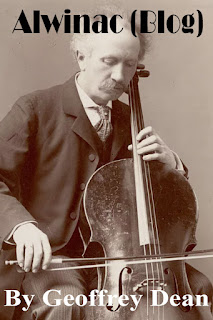 |
| [Click on image to go directly to the Alwinac’s home page] |
Born in Germany in 1829 or 1830, cellist Theodore Ahrend studied in Brussels, where he may have worked with Francois Servais. In 1849 he performed solos at the Berlin Royal Opera and on the Leipzig Euterpe concerts. His first US appearance was in New York on Dec. 27, 1951, on a benefit concert for the American Musical Fund Society: “…Herr Ahrend, upon the Violoncello, was vehemently applauded, notwithstanding his decided inferiority to the lamented Knoop.” Over the next two years he performed as a soloist with Wood’s Minstrels in New York, on vocalist Caroline Richings’ concerts in Washington, D.C., and with the Concordia Concert Troupe for an extended summer 1853 engagement in Charleston, SC.
It was in Charleston that Ahrend debuted as cello soloist with Kunkel’s Nightingale Opera Troupe, on October 24, 1853. Led by the banjo-playing bass George Kunkel and managed by J. T. Ford (at whose Washington D. C. theatre Lincoln was assassinated), the Baltimore-based Kunkel troupe was a minstrel company, touted as “the most versatile corps of Ethiopian Delineators now before the public[,]…introducing in their entertainments the Songs of the Boudoir and Plantation, embodying many new and pleasing features in their portraitures of Ethiopian life.” One of the Nightingales’ specialties was a pro-South version of Uncle Tom’s Cabin presenting Harriet Beecher Stowe’s title character (portrayed in blackface by Kunkel) as contented with plantation life.
 |
| Ad in Washington D. C. Union of Sunday, June 4, 1854, p. 3 |
_______________
Read on….
| Copyright © 2022 by Geoffrey Dean |
A curious terrain Ahrend landed himself in! I quote from “George Kunkel’s Opera Troupe Tokens of Baltimore”:
ReplyDeleteGeorge Kunkel was one of the first promoters of the 19th century genre of Minstrelsy in the United States. Born in Greencastle PA in 1821, Kunkel first arrived in Baltimore in 1855. There he became associated with three prominent places of theatrical entertainment in the city.
Minstrelsy were acts and shows which cast a negative light on American minorities. At the expense of non-whites, the shows unfairly depicted minorities as buffoonish, superstitious, feeble-minded, and clumsy.
A typical minstrel show consisted of comedic skits, accompanied by dancing, music, and variety acts; All performed by white entertainers who wore black makeup.
By the late 1840s, minstrel shows had become quite popular in America, with many shows having adapted once artful operas into cheap boorish parodies.
Given the adaptation of the opera genre, these companies of actors and their managers became known as ‘Opera Troupes.’